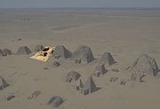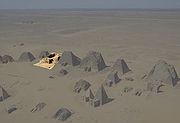
Amanishakheto
Encyclopedia
Amanishakheto was a Kandake
of Nubia
. She seems to have reigned from 10 BC to 1 AD, although most dates of Nubian history before the Middle Ages are very uncertain.
In Meroitic hieroglyphs her name is written as Amanikasheto (Mniskhte or (Am)niskhete). In Meroitic cursive she is referred to as Amaniskheto qor kd(ke) which means Amanishakheto, Qore and Kandake ("Ruler and Queen").
 Amanishakheto is known from several monuments. She is mentioned in the Amun
Amanishakheto is known from several monuments. She is mentioned in the Amun
-temple of Kawa
, on a stela from Meroe
, and in inscriptions of a palace building found at Wad ban Naqa
, from a stela found at Qasr Ibrim
, another stela from Naqa
and her pyramid at Meroe (Beg. no. N6).
Amanishakheto is best known from a treasure of jewellery recovered in 1834 from her pyramid in Meroe by Italian explorer Giuseppe Ferlini
. These pieces are now in the Egyptian Museum of Berlin
and in the Egyptian Museum of Munich
.
She is known for having defeated a Roman
army sent by Augustus
to conquer Nubia, having broken a favourable peace treaty.
Kandake
Kandake or Kentake, also Candace, was the title for queens and queen mothers of the ancient African Kingdom of Kush, also known as Nubia and Ethiopia....
of Nubia
Nubia
Nubia is a region along the Nile river, which is located in northern Sudan and southern Egypt.There were a number of small Nubian kingdoms throughout the Middle Ages, the last of which collapsed in 1504, when Nubia became divided between Egypt and the Sennar sultanate resulting in the Arabization...
. She seems to have reigned from 10 BC to 1 AD, although most dates of Nubian history before the Middle Ages are very uncertain.
In Meroitic hieroglyphs her name is written as Amanikasheto (Mniskhte or (Am)niskhete). In Meroitic cursive she is referred to as Amaniskheto qor kd(ke) which means Amanishakheto, Qore and Kandake ("Ruler and Queen").

Amun
Amun, reconstructed Egyptian Yamānu , was a god in Egyptian mythology who in the form of Amun-Ra became the focus of the most complex system of theology in Ancient Egypt...
-temple of Kawa
Kawa, Egypt
Kawa is a town in Sudan. Located in ancient Nubia between the Third and Fourth Cataracts of the Nile. Noteworthy archaeological discoveries include several Twenty-fifth dynasty of Egypt era steles .-References:...
, on a stela from Meroe
Meroë
Meroë Meroitic: Medewi or Bedewi; Arabic: and Meruwi) is an ancient city on the east bank of the Nile about 6 km north-east of the Kabushiya station near Shendi, Sudan, approximately 200 km north-east of Khartoum. Near the site are a group of villages called Bagrawiyah...
, and in inscriptions of a palace building found at Wad ban Naqa
Wad ban Naqa
Wad ban Naqa is the name of an ancient town of the Kushitic Kingdom of Meroë in present-day Sudan. The village lies on the eastern bank of the Nile, about 80 kilometers upstream of Meroë and about 40 km southwest of Shendi...
, from a stela found at Qasr Ibrim
Qasr Ibrim
Qasr Ibrim is an archaeological site in Lower Nubia. It was originally a major city perched on a cliff above the Nile, but the flooding of Lake Nasser after the construction of the Aswan High Dam transformed it into an island and flooded its outskirts. Qasr Ibrim is the only major archaeological...
, another stela from Naqa
Naqa
Naqa or Naga'a is a ruined ancient city of the Kushitic Kingdom of Meroë in modern-day Sudan. The ancient city lies about 170 kilometers north-east of Khartoum and about 50 kilometers east of the Nile River...
and her pyramid at Meroe (Beg. no. N6).
Amanishakheto is best known from a treasure of jewellery recovered in 1834 from her pyramid in Meroe by Italian explorer Giuseppe Ferlini
Giuseppe Ferlini
Giuseppe Ferlini , of Bologna, Italy, was an Italian doctor turned explorer and archaeologist who destroyed over 40 pyramids in a quest for treasure in the 1820s in Egypt and Sudan. He served as surgeon the Egyptian army, occupying Sudan...
. These pieces are now in the Egyptian Museum of Berlin
Egyptian Museum of Berlin
The Egyptian Museum of Berlin is home to one of the world's most important collections of Ancient Egyptian artifacts.The collection is part of the Neues Museum.-History:...
and in the Egyptian Museum of Munich
Staatliche Sammlung für Ägyptische Kunst
The Staatliches Museum Ägyptischer Kunst in Munich is the Bavarian State Collection for Ancient Egypt art. It displays exhibits from all periods of Ancient Egypt's history. The associated small Middle East section displays objects from the areas of Assyrian and Babylonian culture...
.
She is known for having defeated a Roman
Ancient Rome
Ancient Rome was a thriving civilization that grew on the Italian Peninsula as early as the 8th century BC. Located along the Mediterranean Sea and centered on the city of Rome, it expanded to one of the largest empires in the ancient world....
army sent by Augustus
Augustus
Augustus ;23 September 63 BC – 19 August AD 14) is considered the first emperor of the Roman Empire, which he ruled alone from 27 BC until his death in 14 AD.The dates of his rule are contemporary dates; Augustus lived under two calendars, the Roman Republican until 45 BC, and the Julian...
to conquer Nubia, having broken a favourable peace treaty.
Further reading
- Laszlo Török, in: Fontes Historiae Nubiorum Vol. II, p. 723-725 (Bergen, 1996). ISBN 82-91626-01-4

